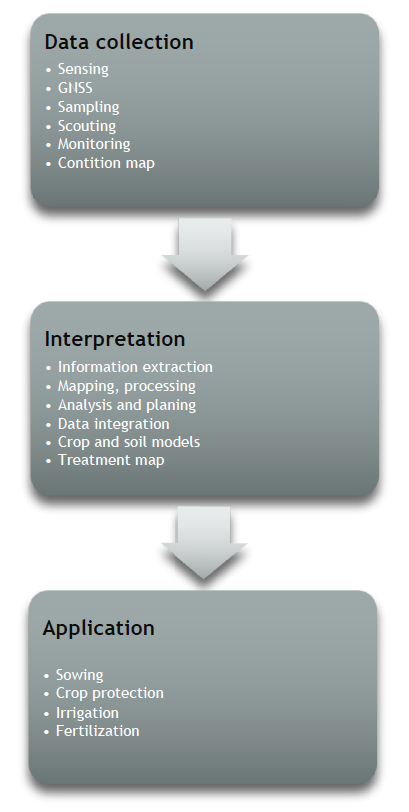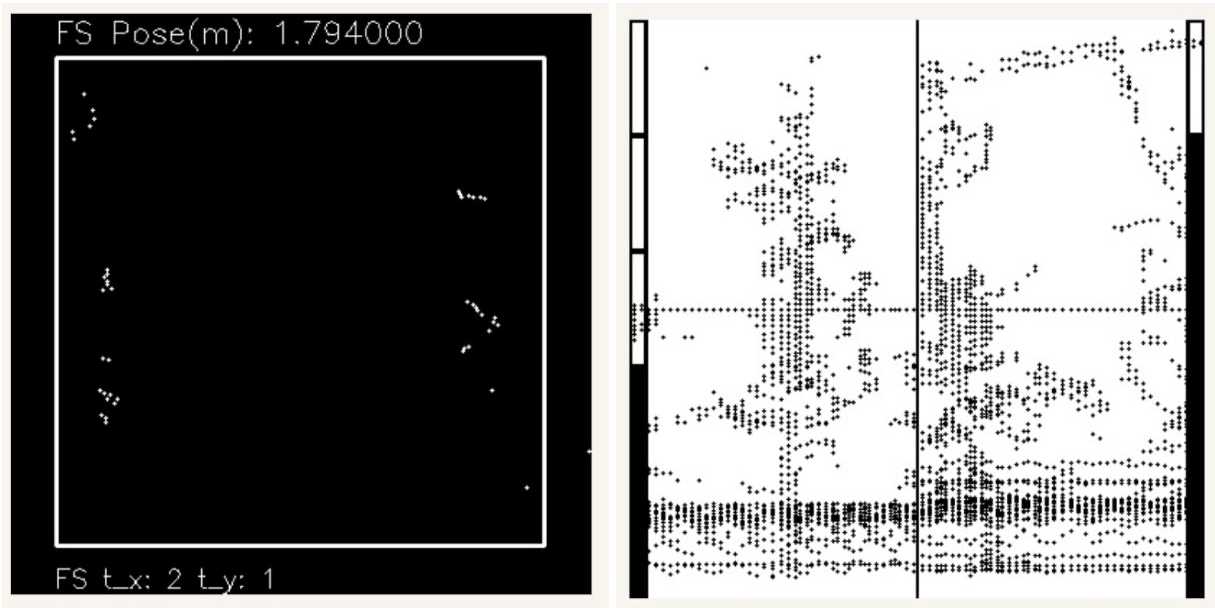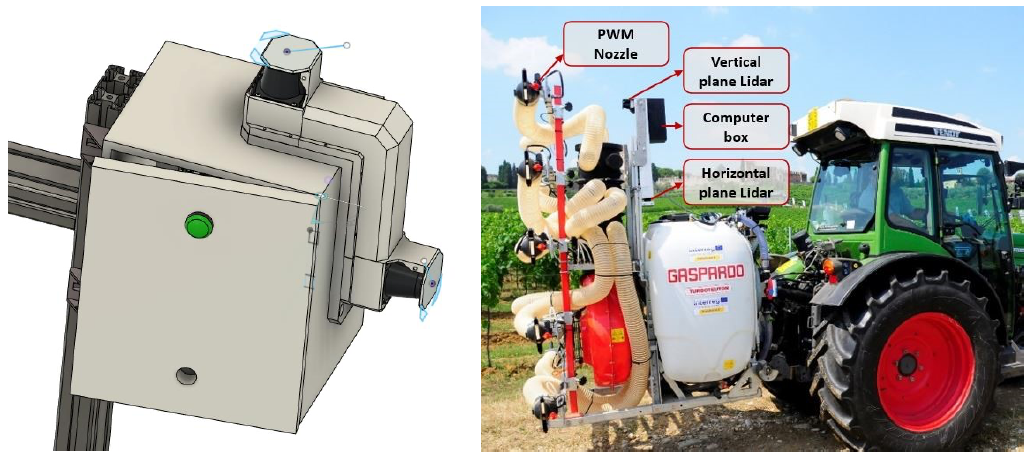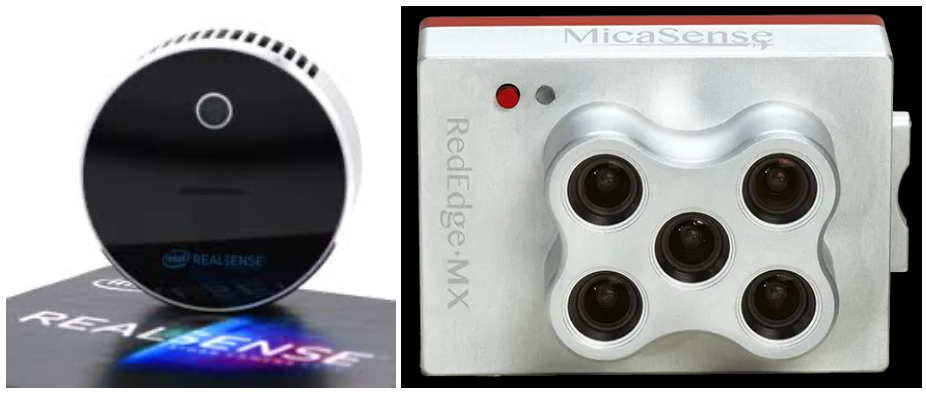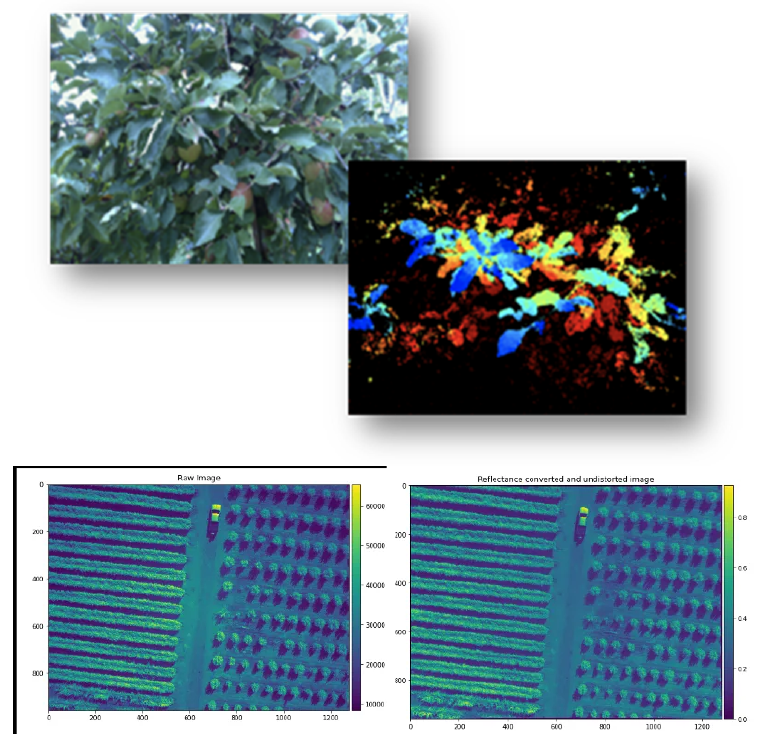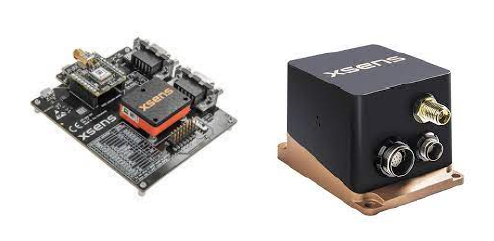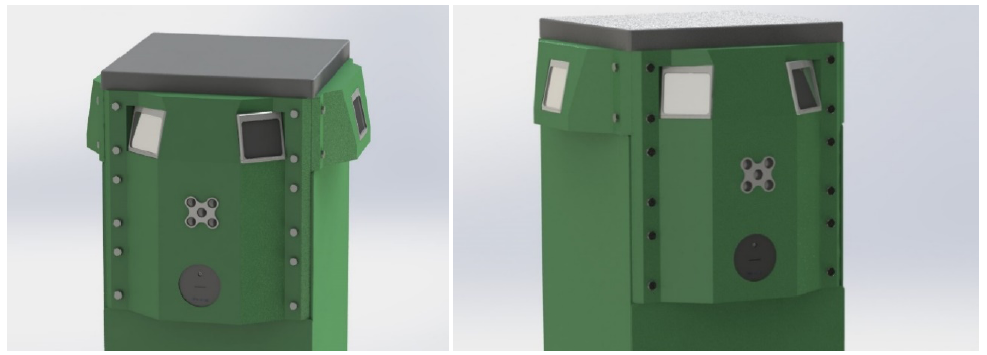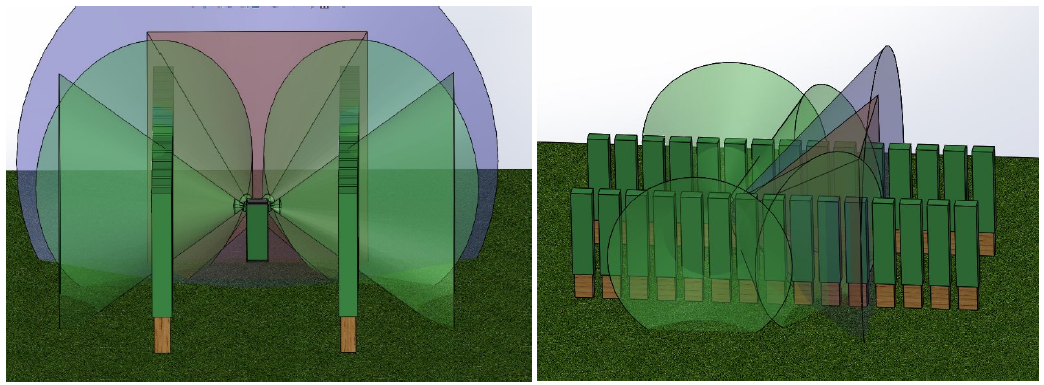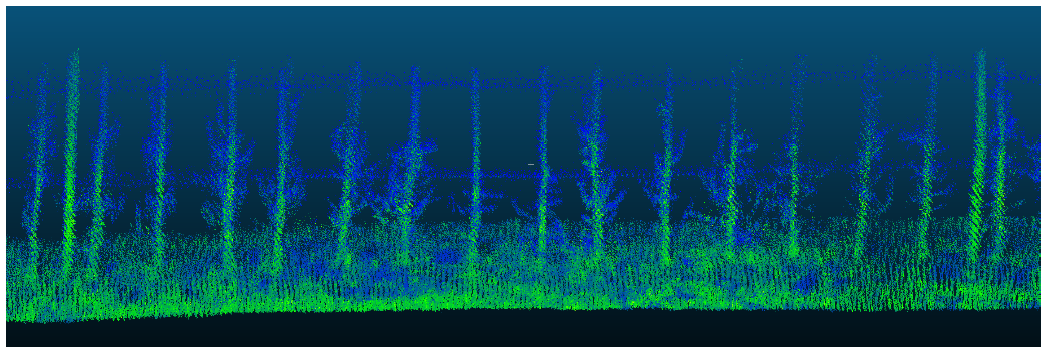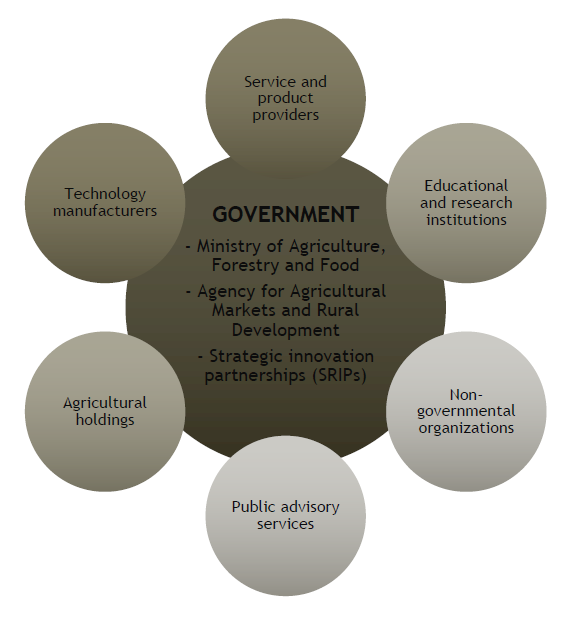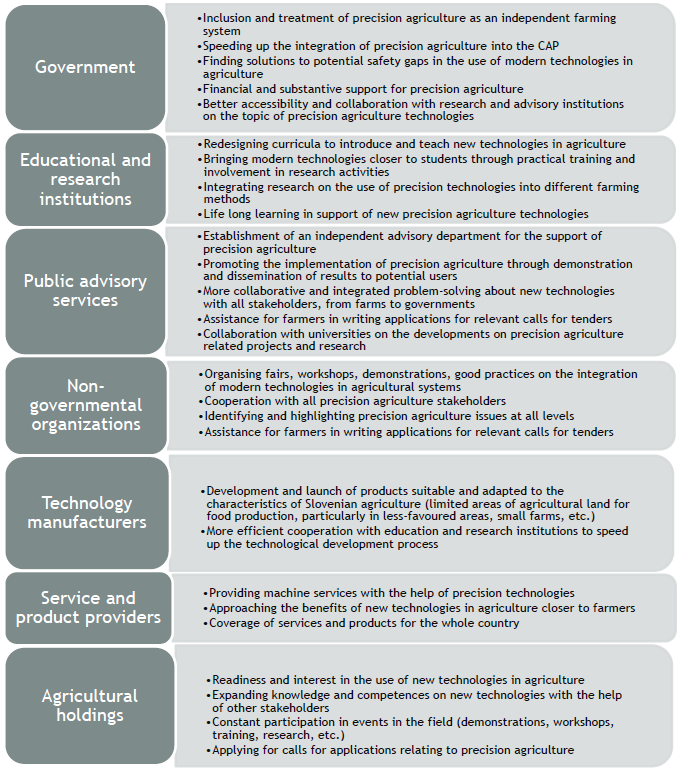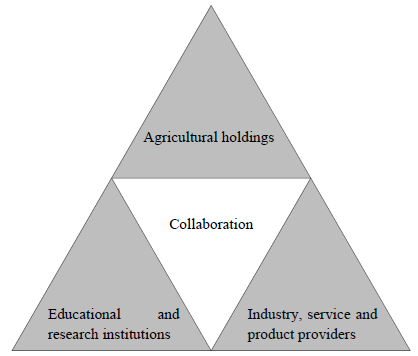REGIONAL ACTION PLAN SLOVENIA
D.T3.1.5 UM, AE-ROBO May 2022
PDF version you can download here.
Precision agriculture
Precision agriculture (PA), through the use of innovative technologies, is a farm management concept that can be used to increase long-term efficiency, manage uncontrolled change and reduce negative impacts on the environment. PA uses new technologies and innovations, combined with site-specific agronomic expertise. Pa maximizes production efficiency and increases the quality of agricultural produce without increasing environmental burdens. A is defined as an integrated approach to agriculture, which is not only synonymous with precision agriculture technologies (PATs) but is also a systems approach to the whole agricultural production. PA has been developed through the expertise of different disciplines.
The main (overarching) objective is to reduce decision uncertainty in agricultural work processes by focusing on better understanding users and managing uncontrolled change. Suppose variability in the field is a significant source of uncertainty. In that case, it is essential to manage appropriate PA processes that can respond to variable factors at the level of spatial and temporal distribution.
The formation of the PA cycle is further defined by Comparetti (2011), who defines PA methods in the following stages (shown in the following diagram):
- Data collection (measurement of spatially variable soil, crop, or yield parameters within the field and monitoring of local weather conditions)
- Interpretation (integration and mapping of input/output applications with different models)
- Application (application of variable inputs based on the results of data processing)
Precision agriculture technologies, through sophisticated analysis of production resources, create significant opportunities to improve the efficiency of farming operations while contributing to solutions for sustainable agriculture and the environment. The availability of new technologies - farm machinery automation, geospatial tools, sensor and information systems, and others - enables precision farm management. In addition to generating accurate and integrated data sources needed for spatial variability decisions, PATs contribute to data diagnostics that link mapped field locations to the most appropriate decisions on sowing, fertilizer inputs, irrigation, crop protection products, crops, etc. They make it easier to manage inventories and account for costs by automatically recording input usage and tracking data
There is no single typology of PATs. However, it can be defined as follows.
- GPS (global positioning system)
- Geographic information system (GIS)
- Sensor systems
- Variable rate technology (VRT)
- Yield mapping (YM)
- IoT (Internet of things)
In the diagram below, we have outlined some of the basic components of precision agriculture technologies.
Precision agriculture has enjoyed a remarkable expansion and popularity in some parts of the world, especially where more intensive farming practices are present. Farms use advanced machinery in a wide range of agricultural sectors. The North American market plays a leading role in PA. The European, Asian, and South American markets also have a significant share. Europe's innovative potential in PA is great and an important lever for agricultural prosperity. In Europe, precision agriculture market was worth USD 2.21 billion in 2021 and projected to grow at a CAGR of 13.2%, to reach USD 3.18 billion by 2026.
Characteristics of Slovenian agriculture
Slovenia is one of Europe's smaller countries, both in terms of land area and population. According to the OECD typology, Slovenia has intermediate (27.2%) and rural regions (72.8%). More than half of Slovenia's land territory is covered by forests, and 34% of its land area is predominantly agricultural. Slovenia is characterized by a dispersed and sparse population and a large number of small settlements. In Slovenia, agriculture with hunting, forestry and fishing contributes 2.3% (2019) to total value-added and 6.9% (2019) to full employment. The share of employment in agriculture is a declining trend and thus decreases year on year.
In Slovenia, decreasing the number of agricultural holdings continues, while the average size of a farming holding increases yearly. On average, a large agricultural holding in Slovenia cultivates 7.0 ha of agricultural land and manages an average of 5.6 ha of forest. Compared to the EU-28, Slovenia still has a very unfavorable size structure of agricultural holdings. The average age of farm owner (manager agricultural holding) in Slovenia amounted to 57 years (2016), which indicates a markedly unfavorable age structure in agriculture. In 2019, 745 companies were operating in the food processing industry, employing 14,627 people. Value-added was EUR 604 million and value-added per employee was EUR 41,270 EUR. Grassland is the most predominant area (84%). Then arable (9%), orchards (intensive and extensive - 4%), vineyards (1.4%), and vegetables (0.7%).
Income in Slovenian agriculture is among the lowest in the EU and represents only around 20% of comparable income in the whole economy. Non-agricultural sources of income are decisive for farming on low-income farms, which can represent a significant part of the income on small farms. Such a poor income situation is the unfavorable structure of Slovenian agriculture with an average of small farms, a large share of land in LFAs, a large percentage of absolute grassland, a large share of non-specialized and self-sufficient farms. Existing processes of Slovenian restructuring agriculture in the direction of increasing income are too slow. Subsidies (direct and LFA payments) are a significant factor in Slovenia, at least partly improving the lower-income situation. Specific agricultural sectors (arable crops, other permanent crops, mixed farming, other grazing livestock), economic farm size (up to EUR 50,000 standard income), and farm location (in LFAs) would generate negative value-added if they did not receive subsidies. Uncertainty about incomes and low productivity leads farms to stagnate investment and, in the long term, to lose competitiveness. Instability is a significant problem in Slovenian agriculture. Fluctuations in prices and/or agricultural volumes can cause liquidity problems for farmers. Uncertainty about incomes and low productivity leads farms to stagnate investment and, in the long term, to lose competitiveness. Uncertainty also causes stagnation or even contraction of agricultural production.
Multiple factors affect the competitiveness and productivity of Slovenian farms; 73.7 % of farms are located in less-favored areas (of which 73.3% - are mountain areas, 10.8% - are areas with natural handicaps, 15.9% - specific constraints), climate change (storms, frost, drought, floods, strong wind, ...) and role of technology (state of machinery/equipment, digitalization, knowledge and innovations in relation to precision agriculture technologies).
There is a strong divide between productivity indicators between EU-27 countries and Slovenia; on average, the divide in EU countries is caused by the introduction of new technologies that substitute the workload. In Slovenia majority of the work is done by manual labour (avg. size 7 ha), and lacking new technology. Farms located in mountain areas face special challenges, shorter vegetation periods and lower income per farmland. Due to the limitations, these farms primarily focus on animal production. An additional factor that limits the possibilities on these farms are the inclinations of farmland that require expensive special-purpose machinery.
Promoting knowledge, innovation, and digitalisation in agriculture in Slovenia
There are several research and training institutions working in the field of Slovenian agriculture and forestry institutions. Public services have been working for decades for the advancement of agriculture and forestry, for better performance of professional tasks in agriculture (livestock farming, crop production, forestry, genetic). Access to formal as well as non-formal education is good. Identified needs and necessary actions in this area:
- Strengthening capacity building and knowledge transfer.
- Strengthening cooperation between the research sphere, consultants, and end-users.
- Strengthening research and development, innovation in agriculture, forestry, and food.
- Retrieved from agricultural advice.
- Digitalisation in agriculture, food, forestry, and rural areas.
- Strengthening digital competences.
Analysis of the factors impacting on the adoption or non-adoption of precision agriculture technologies
The awareness and implementation of new technologies in agriculture, which also includes PA, is reflected in numerous factors in a specific smaller area, such as on a farm, at national or even international level. Based on the literature reviewed, the table below shows the most influential factors.
| Factor | Description |
| The personality and family structure of the farm owner | Age, education, computer usage, skills |
| Features of the farm | Farm size, farm type, ownership, specialization |
| Social interactions | Local cultures, local cooperation, human relations – attitude of trusted friends |
| Economic factors | Return on investment time, the possibility of rental technologies, technology costs |
| Policy support | Legislation, measures, strategic plans, vision |
| Supporting institutions and firms | Numbers of supporting institutions and firms |
| Multidisciplinary cooperation | Active participation of all stakeholders in PA |
| Features of the technology | Availability of technologies, easiness of use, systems compatibility |
SWOT analysis of precision agriculture in Slovenia
With the help of the SWOT analysis, we summarized the current situation and guidelines for the development of precision agriculture in Slovenia in four aspects (advantages, opportunities, dangers, shortcomings). The purpose of the analysis is primarily to assist decision-makers in strategic decisions regarding precision agriculture in the future and to assist in further research in this area. The SWOT analysis included summaries of the state of EU and Slovenian policy measures, characteristics, and structure of Slovenian agriculture, as well as the results of a survey obtained in this project (Transfarm 4.0) on the topic of precision agriculture.
| Strengths | Weaknesses |
| Farm owners are aware of the potential of PATs
(precision agriculture technologies). More than three-quarters of farm owners are already educated about PATs. There is more and more research development and talk about PATs. |
PATs require a high initial investment.
Complex and sometimes unreliable PATs. |
| Opportunities | Threats |
| Accelerate sustainable agriculture through
technological development. Interaction of farm owners with ideas / solutions. Optimization of agricultural work, processes, reduction of environmental impact, management of uncontrolled changes and support decision-making. |
Questionable willingness and maturity of farm
owners for the implementation of PATs. Complex quantification of PATs advantages. Questionable knowledge about open opportunities or fear of farm owners’ interactions. Prejudices of farm owners about the maintenance costs of PATs. |
Slovenian Smart Specializations Strategies (S4, Slovenian S3)
Slovenia, as one of the smallest EU member states, has limited resources, capacities, and capabilities, so largely dependent on intensive investments, high risks, high responsiveness and uniqueness, originality. This was considered when the Slovenian Smart Specialization Strategies (therefore S4, and not S3) were drafted with the goal to enhance cooperation between Slovenian innovation stakeholders that operate in specific priority areas. One of the first task to shape S4 was to open a public discussion by attracting companies, research organisations, start-up community, social entrepreneurs, artists, innovators, scholars, students, and others to participate in entrepreneurial discovery process and to identify priority areas, conceptual leaders with the government as the facilitator. The entrepreneurial discovery process made possible that stakeholders operating in a specific S4 priority area have recognised the need for comprehensive and systematic cooperation amongst themselves and with the government.
According to the identified priority areas from the draft of S4 Slovenia launched a public call in 2016 to form nine Strategic Research and Innovation Partnerships or SRIPs. These include (with examples):
• SRIP Factories of the Future Demo project like GOSTOP (Building Blocks, Tools and Systems for the Factories of Future) include the development of new products and technologies, which will lead to the set up of uniform integrated systems, needed by big production companies and provided by SMEs.
• SRIP Health-Medicine Project Medical Valley describes a new university campus focusing on pharmacy, biomedical technology, biomimetic and biotechnology, included in a new regional proton radiation therapy cancer treatment centre.
• SRIP Materials as End Products Formed a cooperation between its members with the goal to the development of new joint developments. like so-called 'hot work tool steels', new light-weight high-strength construction steels, new (recycled) Al alloy and new multicomponent magnetic material based on thermosets.
• SRIP Mobility Formed EDISON (Eco Driving Innovative Solutions and Network) partnership which focuses on the development of inductive wireless charging systems for electric vehicles, the development of new drives and applications and platforms for electro mobility.
• SRIP Networks for the Transition of the Circular Economy Formed a strategic R&D program named Cel.Krog that aims to exploit the potential of biomass for development of advanced materials and bio-based products.
• SRIP Smart Cities and Communities Established the Digital Innovation Hub Slovenia, a national one-stop-shop to help Slovenian companies to become more competitive in respect to processes, products or services using digital technologies.
• SRIP Smart Buildings and Homes On of the activities involved Wood Chain demo project which development of a new terrain tracking and monitoring service, by using orthophoto images, that enables digital verification of construction, with the concept of 3D design of the environment.
• SRIP Sustainable Food Production Established a completely new cooperation between stakeholders in dairy processing sector, meat sector, fruit sector and cereal sectors to form new value chains.
• SRIP Sustainable Tourism Formed Tourism 4.0 demo projects, focused on creating a new format of dynamic collaboration system, with applications, services and processes built on real-time tourist needs and wishes. SRIPs were formed to support investment and intellectual potential of Slovenian stakeholders and were shaped as a long-term quadruple helix bottom-up partnerships, that brings together dynamic companies (like SMEs), research institutions, innovation users and also State and municipalities that operate in a specific S4 priority domain. In three years more than 780 stakeholders joined SRIP partnerships, out of which 83% were enterprises (79% SMEs).
S3 / S4 in Respect to Precision Agriculture
By definition precision agriculture represents an interdisciplinary approach to farming. By applying technology, the farmers / producers can optimize the yield of the production and minimize the input resources, maximizing the profit in return. By recording, measuring, and observing with relative readings the variability of the crops is detected, followed by actions to treat it, if necessary. These include soil cultivation, sowing, spraying, fertilization and other. By applying the right treatment in the right time frame, the producer will gain economic and ecological improvements by: maximizing the quality of the crop, reduce input resources, like seeds, chemical products and fuel, it will minimize the possible negative environmental impact, reduce the work hours needed and (auto) produce a complete production documentation. Although the importance farming has in Slovenia, the Slovenian’s smart specialization strategy S4 does not address precision agriculture with a dedecated SRIP, instead its support can be directly or indirectly found in already existing SRIPs. The two SRIPs that are directly linked to precision agriculture are SRIP Sustainable Food Production and SRIP Factories of the Future.
• SRIP Sustainable Food Production
SRIP Sustainable Food Production (SRIP HRANA) unites agriculture holdings, companies, cooperatives, research institutions, investors and other interested parties toward joint research and development activities to improve agri-food sector development. This involves becoming a national contact point for companies and research institutions to promote networking and cooperation. The SRIP activities are co-funded by the Slovenian Ministry of economic development and technology and the European Regional Development Fund.
SRIP Sustainable Food Prodction defined an action plant that is formulated on the five action pillars that summarize the five objectives of the SRIP strategy. Besides these five action pillars, three horizontal areas that need to be improved have been identified. This are human resource development, internationalization and Information and communication technology (ICT). They are incorporated in to the 5 action pillars. These five action pillars are:
AP1 - INGREDIENTS AND SUSTAINABLE USE OF RESOURCES
The first action pillar is related to the SRIP Network for the transition the circular economy. It focuses on the sustainable and efficient use of resources for sustainable vegetable food production and processing and for sustainable livestock production.
AP2 - SMART PROCESS PLANNING AND PROCESS CONTROL
Smart process planning and process control is related to SRIP Smart Cities and Communities, and horizontal ICT network. It focuses on optimization of agro-food processes based on automation, digitalization, and robotization.
AP3 - ADVANCED EQUIPMENT AND TECHNOLOGIES FOR SUSTAINABLE FOOD PRODUCTION AND FOOD PROCESSING
The third action pillar is related to SRIP MATPRO and focuses on the development and use of advanced technologies in the production and processing of food to produce interesting, competitive, and innovative production of food products, with food safety, improved nutritional value and higher functionality in mind.
AP4 - HYGIENE, SAFETY AND QUALITY OF FOOD
The fourth action pillar focuses on ensuring food safety, detecting food fraud at all stages of food production and processing by development of new innovative products and services for ensuring the safety and quality of finished products.
AP5 - FOOD, NUTRITION AND CONSUMER
The fifth action pillar is related to SRIP Health-Medicine and SRIP Sustainable Tourism. It focuses to develop a system that will lead to the innovation development of the entire agrofood chain by promoting the invention of functional food products for individual target groups.
• SRIP Factories of the Future
SRIP Factories of the Future is the largest SRIP, lead by Jožef Štefan Institute. It is divided into four clusters:
- Advanced technologies cluster (led by Jožef Štefan Institute),
- Smart factories cluster (led by Chamber of Commerce and Industry of Slovenia).
- Systems and control technologies cluster (led by KC STV),
- Toolmakers cluster (led by Tecos).
The SRIP FoF is devided into the following pillars.
AP1 - ADVANCED SENSORS
This pillar addresses the importance of advance sensors in autonomous and smart systems. And includes the following focus areas:
- Advanced micro and nano sensors for process control - to increase the competitiveness of end products.
- 3D sensor systems - to increase the competitiveness of end products.
- Smart nano/bio/chemo sensors in the environment, industry, and medicine - to increase the competitiveness of end products.
AP2 - INTELLIGENT LASER SYSTEMS
Laser Systems play an important part in research and development sector, with the largest production of solid laser systems per capita. This pillar includes the following focus areas:
- Special laser sources - to develop new laser sources.
- Intelligent laser systems for the digital processing of materials - to develop high-tech additive laser systems for the semiconductor industry.
- Smart medical laser devices - for the use of laser sources in medicine (regeneration, therapeutics, dermatology).
- Next generation optical fibres - to develop special active and passive fibres for IR and UV.
AP3 - INTELLIGENT MANAGEMENT SYSTEMS FOR FUTURE FACTORIES
Future Factories promise a better-quality products, better efficiency, time, and cost savings in real time. An important part of this are the Internet of Things (IoT) and Services. This pillar includes the following focus areas:
- Smart actuators - for complete surveillance and cost optimization.
- Distributed control systems and IoT - device and sensors control in industrial processes using IoT.
- Intelligent Production Management Systems (MES-MOM) - to develop advanced software solutions for management and decision support.
- Diagnostics, prognostics and self-maintenance of smart machines and processes - to develop
advanced software solutions and modules for predictive maintenance of machines and devices.
- Development of modern tools and building blocks for the management and control of systems and processes - to improve lithographic procedures in microelectronics with the appropriate control of the mass production process.
AP4 - NEW MATERIALS
New materials enable technological advancement in all areas of society and is the basis for its sustainable development. The pillar includes the following focus areas:
- Magnetic materials with a minimum quantity of rare earths - to develop and production of magnets, that will replace the need to use rare earths.
- Environmentally friendly materials for protective elements in electrical engineering and electronics - to increase the production and sales of products to improve the content of materials.
- Functional coatings - inclusion of new materials into products.
AP5 - ROBOT SYSTEMS AND COMPONENTS
Represents one of the fundamental pillars of Factories of the Future. With new intelligent sensors, actuators and other advanced robotic components, the flexibility of the robots will increase. To achieve this, the following focus areas have been defined.
- Manufacture of new robots - with the aim to put Slovenia on the global map of robot and robot parts manufacturers. This includes the development of new agricultural robots driven by artificial intelligence.
- Innovative intelligent and sensor supported robot applications (advanced mechanical vision) - to introduce new sensory system, such as machine vision to improve the flexifile and autonomy of robotic systems.
- Intelligent sensors and actuators for the use of robotics - to produce and market advance components of state of the art robots.
- Development and marketing of flexible and cooperative robot cells - to use superior multidisciplinary technological knowledge to use robotic building blocks into automated cells and lines.
AP6 - SMART FACTORY
This pillar joins all vertical value chains and horizontal networks in the area of SRIP FoF and wider. It's an umbrella like process with defined contact / control points that will make the digitalization the most important process in companies making an increase in the added value of its processes. It includes the following focus area:
- Optimal (individualized) comprehensive solutions for the implementation of smart factories - defining the implementation of the Smart Factory and establishing a value chain to transform the cooperation with the partner company.
AP7 - SMART MECHATRONIC TOOLS
Complex mechatronic systems are making possible to build advanced and smart industrial tools. These systems are used for monitoring, regulation and communication between devices and external devices / machines to improve the usefulness of this smart machines. This pillar includes the following focus areas:
- Smart mechatronic tools - used to increase smart tools investments for tool makers.
- Linking simulation tools with manufacturing machines to optimize production processes
- used to simulate and optimize the production process, to minimize defective products and to ensure the production with as short as possible deadlines.
- Advanced production process and prototype technologies - to merge existing development centers into one, supported by Sloveninan manufacturing industry to support SMEs.
In addition to this action pillars six horizontal areas have been identified, which provide key technologies. These are:
- Management Technologies
- Modern Technology for Materials
- Nanotechnology
- Photonics
- Plasma Technology
- Robotics
Interviews with S3 managers – SRIP Factories of the future
Meeting date: 1st of June 2022: 9.00 - 10.30
Zoom platform for online meeting
Attandees:
Živa Antauer - SRIP TOP
Jurij Rakun – UM, FKBV
Erik Rihter – UM, FKBV
Peter Lepej – AE-ROBO
Agenda of the meeting:
To discuss the S3 regional specializations managers regarding the current and future inclusion of precision agriculture in SRIP TOP (Factories of the future); to identify the links between innovation strategies and the agricultural production sector, to promote technological development, implementation of regional innovations, support for the agricultural production sector and support for the education system with the possibility of directional training for agricultural needs.
Conclusions:
Agriculture is not the main sector
SRIP TOP is one of 9 designated S3 / S4 areas in Slovenia. It does not support agricultural sector directly, but indirectly by supporting other horizontal areas such as smart plasma and (agricultural) robotics. In addition to this AI horizontal area could support precision agriculture in the future.
How can SRIP TOP support knowledge transfer in the field of PA and wider?
Part of SRIP TOP’s work is to offer support, which also includes organization of different events led by GZS (Slovenian chamber of commerce), TECOS (industrial cluster) and Jozef Stefan Institute. This events also support knowledge transfer, indirectly to the field of PA.
System of technological incubators and laboratories for Industry 4.0 companies
SRIP TOP itself is not an incubator or does not provide one, but its partner organizations are, including: Pomurski tehnološki park, Savinjsko – Šaleška razvojna agencija SAŠA, Podjetniški inkubator Novo mesto, CS Škofja Loka and others.
System of technological incubators and laboratories for Industry 4.0 companies SRIP TOP itself is not an incubator or does not provide one, but its partner organizations are, including: Pomurski tehnološki park, Savinjsko – Šaleška razvojna agencija SAŠA, Podjetniški inkubator Novo mesto, CS Škofja Loka and others.
Can SRIPs offer their support in the preparation of new project calls?
SRIPs members do work to identify new possible priority arias, but they can not influence how new project calls will be prepared, what will be their focus point, when they will be opened, etc. The partner organizations work to promote different identified strategic priority areas, but their influence on new project calls is very limited; their work can be included or not. As SRIP members play a key role in different areas, their contributions could make a difference, but are usually not included and their potential is currently overlooked.
Does SRIP TOP offer some kind of activities in terms of supporting educational activities
Yes, for instance GZS covers human resource’s part and in this respect offers a range of educational activities for members and wider.
Could PF become one of the horizontal areas of SRIP TOP?
SRIP TOP is finalizing the action plan for the next three-year long period. If members of SRIP TOP identify PF as one of the priority areas, it could be added to the next action plan after the next period. Especially, as PF already has specific domain ties to existing priority areas.
Are there currently any members of SRIP TOP that would fit the scope of PF
As mentioned, the smart plasma horizontal is involved in the processing of plant seeds. Artificial intelligence horizontal is involved in data mining. It is almost sure that other members members activities fall in the scope of PF (maybe agro-robotics).
How do you see that PF could be moved closer to the target groups
The faculty (FKBV) is invited to join the SRIP TOP. As different member faculties of the University of Maribor are already members of SRIP TOP, this should be a kind of simplified process. FKBV can then focus on areas like PF, that other UM member faculties do not cover.
Interviews with S3 managers – SRIP Smart Cities and Communities
Meeting date: 26th of May 2022: 9.00 - 10.30
Zoom platform for online meeting
Attendees:
Nevenka Cukjati - SRIP PMIS (S3 Smart cities and communities)
Jurij Rakun – UM, FKBV
Erik Rihter – UM, FKBV
Peter Lepej – AE-ROBO (partly present)
Agenda of the meeting:
To discuss the S3 regional specializations managers regarding the current and future inclusion of precision agriculture in SRIP PMsS (Smart cities and communities; SCaC); to identify the links between innovation strategies and the agricultural production sector through links at the level of technological development, implementation of regional innovations, support for the agricultural production sector and support for the education system with the possibility of directional training for agricultural needs.
Conclusions:
Agriculture is not the main sector
Agriculture is not the main sector of the SRIP PMiS, but with the new strategic plan that is under development this will be partly reshaped by covering areas like adaptation to climate changes, clean waters, green environments, etc. This indirectly affects and includes the area of precision agriculture.
How can SRIP PMiS support knowledge transfer in the field of PA and wider?
The role of the SRIPs is not to offer direct support, but to network specific actors in selected area. The domain for knowledge transfer therefore lies with the individual members of SRIPs. System of technological incubators and laboratories for Industry4.0 companies SRIPs do currently not offer this kind of services, as their role is primarily networking different actors. Like knowledge transfer, this is done by the resources and possibilities of individual partners.
Can SRIPs offer their support in the preparation of new project calls?
Directly no. Indirectly the members of the SRIPs identify potential priority areas which can be used in the project. The members of the SRIP are also invited to submit their ideas for new targeted project calls, but this is then filtered and possibly reshaped at the level of the Ministry in charge (Agriculture, Infrastructure, Education, etc.).
How do you see the educational system, could SRIP PMiS support in the preparation of new educational entity to support the PF?
Directly no, but with the support of different partners, different stakeholders, this could be achievable and welcome as PF technologies will play an important role in the future. So joint consensus regarding this should be accepted and based on these subsequent steps can be ensured to prepare the educational system.
Could PF become on of the horizontal areas of SRIP PMiS?
PF is a very important area and should be part of the SRIP PMiS. To start this task, different actors should first be identified and invited to cooperate. With this new partnership a strategic plan should be prepared and evaluated on the national level. Once this is approved, the partners should work, promote, spread their activities in support of PK / SRIP PMiS.
Are there currently any members of SRIP PMiS that would fit the PF scope?
There are multiple members of SRIP PMiS that would fit the scope of PF, for instance: among others, Optifarm and Login5 foundation for example could be invited to join the PF vertical.
How do you see that PF could be moved closer to the target groups?
One way of solving this challenge would be to prepare a model farm that uses new PF technologies that could serve as a demonstration tool for different actors like cooperatives, farming associations, industry, educational units, policy makers and other interested parties.
Regional policy actions about PF
The strategic plan (2023-2027) in Slovenia: contains the key strategic guidelines for the implementation of the Common Agricultural Policy in the Republic of Slovenia. Among the CAP 2014-2020 objectives, the following were important for the precision agriculture: improving agricultural competitiveness, promoting innovation, delivering environmental public goods, and mitigating and adapting to climate change. The studies highlight the current gap in the modernization of farms, innovative approaches, and the use of new technologies for the precision agriculture. They conclude that the use of new technologies remains below expectations and is unevenly spread across the EU. More effective CAP measures in this area are key for the future and balanced funding from both pillars is important for new technologies in agriculture. The CAP objectives are implemented in two ways in a given country for the 2014-2020 period: as direct payments to farmers and through market measures (Pillar I), or under the Rural Development Programme through various forms of subsidies (Pillar II), both supported by an agricultural advisory service, which includes agricultural advisory systems. The CAP has been financed at European level as part of the EU budget since 1999, through two funds, the European Agricultural Fund (EAFRD) and the European Agricultural Fund for Rural Development (EAFRD).
- Pillar I: Appropriate rural development measures in this pillar play an important role in promoting the development of precision agriculture. The determination of measures and financing depends on the individual country or the decision-makers. It is therefore essential to carefully identify the needs for priorities and measures based on the specific local conditions and farming systems that each country wants to achieve in the field of precision agriculture.
- Pillar II: The priorities here are the following: promoting the competitiveness of agriculture, ensuring sustainable management of natural resources and measures in the field of climate change, and achieving balanced territorial development of rural economies or communities by creating / maintaining jobs. Most measures are met through the Rural Development Program (RDP)
To the extent of measures II. pillars available in Regulation (EU) No 1305/2013 of the European Parliament and of the Council of 17 December 2013, the main precise support can be defined in the following articles:
Article 17 (investments in fixed assets),
Article 28 (agri-environmental-climate payments),
Article 35 (participation),
Article 14 (transfer of knowledge and innovation),
Article 15 (advisory services, farm management assistance, support
services).
Resolution: "Our food, rural areas and natural resources after 2021": The purpose of this document is to define the basic strategic framework for the functioning of agriculture, food and rural areas for the period after 2021. The resolution is the basis for the preparation of the single Strategic Plan for the implementation of the CAP national measures and mentions precision agriculture, among all the other important objectives in agriculture for the coming period. It recognises that the agriculture and agri-food of the future will follow the development of digitalisation and modern technologies. Precision agriculture will ensure the achievement of stable production, targeted inputs, reduced environmental burdens and greater economic efficiency. Investment support measures will need to focus on reducing the technology gap as well as the impact of climate change. At the same time, education and training of farmers will be more proactive.
Rural development program: The Rural Development Programme of the Republic of Slovenia for the period 2014-2020 (until 2022, interim period) is a joint programming document of the Republic of Slovenia and the European Commission, managed by the Ministry of Agriculture, Forestry and Food. The document constitutes the programming basis for the absorption of financial resources from the European Agricultural Fund for Rural Development. Based on the definition of the analysis of the situation of agriculture, food and forestry, this document reflects national priorities and covers the whole territory of Slovenia. The needs and areas for action have been identified on the basis of a SWOT analysis. The Rural Development Programme also includes the Rural Network, which can be considered as a stand-alone measure.
The Rural Development Programme (2014) identifies six priority areas for action, out of which measures, sub-measures, and operations for the development of rural development in Slovenia can be indirectly classified under the three areas:
- Accelerating the process of structural adjustment in agriculture and thus creating conditions for increasing the productivity of Slovenian agriculture,
- Promoting agricultural practices that have a positive impact on the conservation of natural resources and adaptation to climate change,
- Transfer of knowledge, innovation, and care for the environment and climate change (horizontal objectives of all five priority areas for action in the Rural Development Programme).
Financial Perspective for every action
The program of the common agricultural policy in Slovenia in the period from 2014-2020 did not envisage direct measures for precision agriculture, but within the existing measures various areas of projects related to precision agriculture and digitalization can be applied. Such measures strengthen the competitiveness of agriculture, also due to the emphasis on research, technology and digitization projects and the dissemination of knowledge to young farmers.
Financial cut in precision agriculture in Rural Development Program 2014-2020:
Measure M1 - Transfer of knowledge and information activities (EUR 7,218,750) - MEASURES TO PROMOTE PRECISION AGRICULTURE
- Sub-measure M1.1 - Support for vocational training and skills acquisition activities
- Sub-measure M1.2 - Support for demonstration activities and information measures
Measure M2 - Advisory services, farm management assistance services and on-farm replacement services (EUR 7,168,000.00)
- Sub-measure M2.1 - Support to assist in the use of counseling services
Measure M3 - Quality schemes for agricultural products and foodstuffs (EUR 3,700,000.00)
- Sub-measure M3.1 - Support for new participation in quality schemes
Measure M4 - Investments in fixed assets (EUR 366,973,880.23) - MEASURES TO PROMOTE PRECISION AGRICULTURE
- Sub-measure M4.1 - Support for investment in agricultural holdings
- Sub-measure M4.2 - Support for investments in processing / marketing and / or development of agricultural products
- Sub-measure M4.3 - Support for infrastructure investments related to the development, modernization or adaptation of agriculture and forestry
- Sub-measure M4.4. - Support for investments to prevent wind erosion on agricultural land
Measure M6: Development of farms and enterprises (EUR 152,983,333.33)
- Sub-measure M6.1 - Start-up aid for young farmers
- Sub-measure M6.3 - Start-up aid for small farms
- Sub-measure M6.4 - Support for investments in the establishment and development of non-agricultural activities
Measure M7 - Basic services and village renewal in rural areas (EUR 14,000,000)
- Sub-measure M7.3 - Support for broadband infrastructure, including its establishment, improvement and extension, passive broadband infrastructure and provision of broadband internet access and eGovernment solutions
Measure M8 - Investments in the development of forest areas and improving the viability of forests (EUR 60,881,066.67)
- Sub-measure M8.4 - Support for the elimination of damage to forests due to forest fires and natural disasters and catastrophic events:
- Operation Elimination of damage and restoration of forests after a natural disaster
- Operation Arrangement of forest trains needed to carry out reforestation
- Sub-measure M8.6 - Support for investments in forestry technologies and processing, mobilization and marketing of forest products:
- Operation: Investments in the purchase of new machinery and equipment for felling and harvesting wood
- Operation: Investments in pre-industrial wood processing
Measure M9 - Establishment of producer groups and organizations (EUR 3,427,950.00)
- Sub-measure M9.1 - Establishment of producer groups and organizations in the agricultural and forestry sector
Measure M10 - Agri-environment-climate payments (EUR 271,127,386.67)
- Sub-measure M10.1 - Payment of agri-environmental-climate obligations (measure KOPOP)
- Sub-measure M10.2 - Support for the conservation, sustainable use and development of genetic resources in agriculture
Measure M11 - Organic farming (88,131,000.00 EUR)
- Sub-measure M11.1 - Payments for conversion to organic farming practices and methods
- Sub-measure M11.2 - Payments for the maintenance of organic farming practices and methods
Measure M13 - Payments to areas with natural or other special constraints (EUR 337,614,928.00)
- Sub-measure M13.1 - Payment of compensation in mountain areas
- Sub-measure M13.2 - Payment of compensation for other areas with significant natural constraints
- Sub-measure M13.3 - Payment of compensation for other areas with special restrictions
Measure M14 - Animal welfare (EUR 51,133,333.33)
- Sub-measure M14.1 - Payment for animal welfare
Measure M16 - Cooperation (EUR 23,028,588.23)
- Sub-measure M16.2 - Development of new products, practices, processes and technologies
- Sub-measure M16.4 - Establishment and development of short supply chains and local markets
- Sub-measure M16.5 - Environment and Climate Change
- Sub-measure M16.9 - Diversification of activities on the farm
Measure M19 - Support for local development under the LEADER initiative (community-led local development) (EUR 67,660,314.20)
- Sub-measure M19.1 - Preparatory support
- Sub-measure M19.2 - Support for the implementation of community-led local development strategies
- Sub-measure M19.3 - Preparation and implementation of LAG cooperation activities
- Sub-measure M19.4 - Support for running costs and animation costs
Measure M21 - Exceptional temporary support for farmers and SMEs particularly affected by the covid-19 crisis (EUR 1,700,000)
113: Early retirement from the RDP 2007-2013
In the new EU common agricultural policy, instead of the existing rules and coherence, the emphasis will be on the results and reasonableness (effectiveness) of the measures. It is up to the Member States to decide for themselves how best to meet the common objectives of European agricultural policy, while responding to the specific needs of their farmers, rural communities and society at large. The objectives of the common agricultural policy for the period 2023-2027 are to constantly adapt to the challenges facing European agriculture. Policy after 2020 will be simpler and will be based on three general and nine specific objectives. The general objectives are underpinned by a horizontal objective and the dissemination of knowledge, with an additional emphasis on innovation and digitalisation in agriculture and rural areas. The Strategic Plan of the Common Agricultural Policy 2023-2027 envisages specific action 2: Strengthening market orientation and increasing competitiveness, also with a stronger focus on research, technology and digitalisation. The financial plan for this measure has not yet been determined.
Learning and growth perspective
This subsection explains the experience, technology state and lessons learned by developing the pilot action 2 focused on proximal sensing application. It is split in four parts that describe the previous work of the project partners, the SACS and ASES systems and concludes with the findings of the group.
Previous work overview
The partners from UM, SMT / AE-ROBO.NET and AMPS s. p. / dr. Lepej collaborated on pilot project 2 with a common goal to advance and to reach a higher level of TRL of a selected prototype solution. Therefore, as part of this pilot, we have evaluated and improved our past work - advanced sensory systems for precise agriculture operations like spraying. Our goal was to select, essess and try to integrate an advanced sensory system that could push forward farming technologies into new levels. Here we were aiming into more precise spraying, crop health inspections, crop evaluations and most important to try to detect sources of potential diseases in the crops with the advanced sensory systems. To achieve these goals different state of art, commercially available sensors were examined.
Spraying Application Control System (SACS)
The SACS includes and advanced sensory systems based on which the prece spraing of plant protection products can be achived. The aim of the SAC system is to improve and automize the spraying task, to be more precise and responsible in terms of sustainable ways of farming. This is possible with the system that detects the presence or abstaince of the plant canopies inside a fruit orchards or vineyards and makes possible to react accordingly; to spray were needed and to stop spraying where plants or part of the plants are missing.
To achieve this the SAC system uses a number of electromechanical components, including:
• Industrial electronics closet and PLA plastics holders for LIDARs.
• SENSORS: 2 x Sick Lidar Tim5xx
• GPS/GNSS module USB G-mouse
• SIGNAL Led: 12V, 22, industrial standards led lights
• PROCESSIONG Unit: Raspberry pi 4B (Rpi)
• PLC: microcontroller for actuation: Controllino MEGA
• ACTUATOR Interface Valves: 13 pins standard agri connector and plug
• POWER: 3 pin standard AGRI plug + one mounted on the system, for external devices (power splitter)
• USER Interface: Server on Rpi, parameter setup, start/stop control
In addition the listed components, the system utilizes an advantage of the FieldSLAM algorithm, that was developed by the partners in the past. This gives the system a unique posibility to position the sprayer in the natural scene. As the nozzles and the sensor cannot be placed next to each other without the influence the spraying has on the data acquisition, the localization is of utmost importance; to know where the readings regarding the presence of the plant canopies were taken and what kind of readings were saved at the current location of the nozzles. An example of the localization and reconstruction of the readings is shown on Figure 1.
So, instead of using complicated and expensive systems like RTK GPS, the system uses two LiDAR sensors. The first, position vertically, captures the readings needed to determine the presence of the plant canopies, while the second, the horizontally positioned LiDAR, help s to position the system. The render of the system and its actual implementation on a state-of-the-art mist blower is depicted on Figure 2.
Advanced Sensory System (ASES)
The partners on this pilot project decided to design, build and test an Advanced Sensory System (ASES) for agriculture purposes. The goal behind ASES was to test different available sensors that could be used to improve the SACS. Therefore different cheap and more expensive sensors were selected in order to evaluate performances and try to find the best availible sensory system for agriculture.
Selected sensors
Various sensor have been selected for this taks, not only the ones limited to agricultre purposes but also more complex sensor systems from other domains.
Distance sensors
Distance sensors can be used to build a precise model of the given environment in the complex row crops environment. For this task we have choose a cheap 3D Lidar camera RealSense LiDAR camera L515 (https://www.intelrealsense.com/lidar-camera-l515/) and more complex Lidar sensors like RoboSenser Bpearl (https://www.robosense.ai/en/rslidar/RS-Bpearl) and solidstate Lidars, for example Livox MID-70 (https://www.livoxtech.com/mid-70).
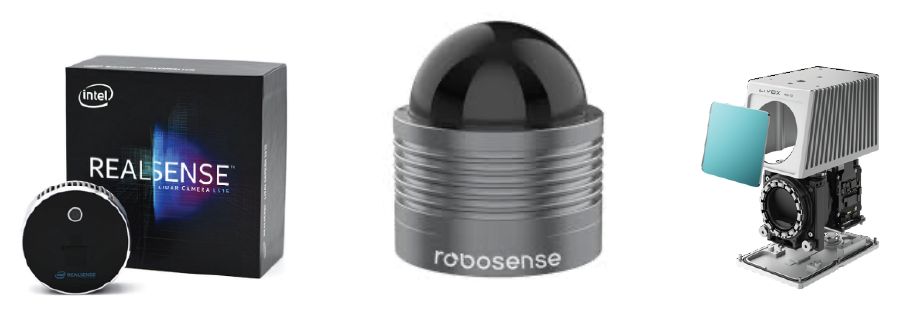
Each sensor has its own specifics in performance and speed, below we show the comparison table of the selected distance sensors:
| Technology: | Range: | Depth Field of View: | Typical usage: | Precision outdoor: | Price aproximate: | |
|---|---|---|---|---|---|---|
| Intel L515 | Pattern projection
(844-875 nm), D*+RGB* |
0,25-9 m | 70° x 55° | Indoor | Poor | 500 $ |
| Bpearl | Time of flight (905 nm),
only D* |
100 m | 360° x 90° | Indoor/Outdoor | Good | 3000 $ |
| MID-70 | Time of flight (905 nm),
only D* |
260 m | 70.4°
(Circular) |
Indoor/Outdoor | Good | 800 $ |
D* - Distance information/data
RGB* - Color information/data
From the simple comparison presendet in the previous table, we can see the advantages and disadvantages from different sensors. The price drop for the solid-state lidar looks promising, plus the technology performance is very good. The Intel Realsense L515 sensor on the other side is cheap and provides additional data of the environment.
The data captured by the sensors that are to be used in agricultural applications need to be reliable in all conditions on the field. In this respect the data from the L515 sensor from Intel Realsense has a lot of disadvantages in outdoor usage as it gives only some party distance data which is affected by the light and its use is therefore limited to night time conditions. A better solition is to use a true LiDAR sensor, preferably solid state that is less prone to problems caused by vibration in the long term.
Cameras
For a more indepth inspection of the growining crops, two camera systems have been evaluated. The purpose behind the visual information of the crop is to get the information of crop texture and also its health.
Figure 9 shows different recordings provided by the camera sensors, where the goals is to use this data to evaluate crops while growing, in the vineyard or apple orchards, to detect anomalies in the growing stage in order to identify possible health issues at early stages.
Inertial Motion Unit (IMU)
The usage of IMU sensor in semi-robotic applications is almost mandatory to receive the updates on the position by including at lesst changes in roll, pitch while traveling in the row crops and accilerations on x, y and z axis. The reason behind this is that the grounds in filed are almost never completely flat and conpensation for these discrepancies needs to be included.
The two sensors that were evalued provide GPS data GNSS and RTK positioning in combination with the inertial information. The two sensors have different performance in reliability, precision, and durability.
Sensor’s integration
As part of the pilot project a system design was made that integrates all previously presented sensors. The housing of the system is modular, so it can be update at any time of the testing phase in accordance with what is needed. The system is show on Figure 6, while Figure 7 shows how principle of how the sensors inspect the proximity.
An onboard computer unit is included to capture and postprocess all the necessary readings. The unit is based on ROS which provides the necessary data, supported by and accurate time stamp and readings of other information from the sensors (statuses, parameters, etc). The result of such postprocessing of the system is shown on Figure 8
Conclusion for Spraying Application Control System (SACS)
The execution of the pilot project 2 lead to a successful cooperation between the Slovenian and Italian partners. It attracted the intention of the partners from the industry on transitional level and progressed the work on the construction and utilization of the digital twin.
The maturity of the demonstrated precision agriculture technologies is at different stages of the development, and it is still being evaluated how to improve its robustness, quality and how to make it cheaper and therefore more accessible. This proved as a vital step and needs some future work planned after the completion of this project.
But most importantly, the potential of the solution was demonstrated, reaching a savings rate on PPPs between up 20% to 30% in well-shaped orchards and more then 50% in extreme cases such as ESCA infected vineyards. But this is just one of the examples how could precision agriculture technologies help the agriculture in the future. Not just that the usage of PPPs will be reduced, it will help the ecology, maximize the yields, and lower the expenses for input resources.
Conclusion and recommendations
Beneficiaries & stakeholders of precision agriculture
In the chart below, we have listed all stakeholders who are in any way related to precision agriculture in Slovenia and beyond.
Indicative strategic plan
Based on the conducted survey and performed SWOT analysis, the following precision agriculture strategic plan is forseen. The chart is divided into seven categories that correspond to interconnected and complementary stakeholders. It identifies some of the key activities and focus areas the needed for the future development of precision agriculture.
Expected results in relation to the key actions identified above
In the following, we set the expected results and goals in different approximate time periods. We highlighted three key stakeholders.
Expected results from the point of view of agricultural holdings
| Indicative period | Expected results |
|---|---|
| 0-1 year | - Applying to calls for proposals related to precision agriculture (with the support of the agricultural advisory service)
- Attending training courses, obtaining appropriate documentation for the use of new technologies, purchasing new technologies |
| 1-5 years | - Implementing and using of new technologies
- Cooperation with agricultural advisory services and associations (demonstration to other farmers, presentations) - Period of active reporting (important from the agency's point of view to get the necessary information) |
| 5-10 years | Transfer of experience (cooperation with agricultural advisory services and associations - demonstration to other farmers, examples of good practice)
- Feedback to all stakeholders (calculations, economic viability, experiences…) |
Expected results from the research and educational field
| Indicative period | Expected results |
|---|---|
| 0-3 year | - Speeding up applications for calls for proposals related to precision agriculture
- Adapting the curriculum (modifying study programmes, promoting interdisciplinarity, preparing students for precision agriculture) |
| 3-10 years | - Implementing projects (involving stakeholders)
- Disseminating knowledge and experiences from abroad - Evaluating and iteration of the results - Accelerating cooperation with companies |
Expected results from the industry, service and product providers
| Indicative period | Expected results |
|---|---|
| 1-10 years | - Adaptation to the needs of the characteristics of Slovenian agriculture
- Support for workshops, demonstrations - Supporting projects - Accelerating cooperation with research institutions |
Besides the expected results for the indicative time periods actions to strengthening the cooperation between individual partners (eg Industry - research / education sphere), not only quadruplex or EIP partnerships, should be introduced. One way of doing so is to introduce different activities trough the inclusion of PF into different strategic innovation partnerships (SRIPs) and wider the model to:
• Include different activities beyond networking, like offering support and advice, incubators, investors, …
• Establishment of a PF development fund (education, dissemination of results, support for startups, etc.).
• Establishment of a regional center of excellence in support of the PF.
In addition to this, the PF should be incorporated in to exisiting SRIPs, like SRIP PMiS and SRIP TOP with the following steps:
• Identification of partners in specific SRIPs.
• Preparation of a draft for SRIP PMiS and TOP to include activities related to PF.
• Contacting and inviting potential partners to prepare a strategic plan for the establishment of a new horizontal area of the PF.
• Meetings and workshops in support of the preparation of a strategic plan that includes; reasons, objectives, tasks, KPIs and milestones in support of PK within SRIP PMiS.
• Promotion, contact and cooperation with external members (eg NGOs ..)
Key performance indicators
Based on the status, multiple target values have been set to evaluate the key performace indicators in the uptake of precision agriculture technologies as show in the following table.
Conclusion
Modernization of agriculture and the use of innovative technologies have given rise to new management concepts, including precision agriculture. The concept of precision agriculture is not yet fully established in Slovenia, but it could be the answer to many of the challenges we face in agriculture. In recent years, the CAP has recognized the potential of precision agriculture through various action plans, resolutions, and funding support schemes and has actively promoted its development in the EU and Slovenia. Positive trends are also promising for the coming programming period. In all the incentive programs and measures under consideration, it is evident that innovative approaches based on collaboration, knowledge building, and co-creation of solutions into practice are key in the pursuit of a successful future for successful agriculture. The large variation in farming structures in Slovenia and elsewhere in the EU poses a major challenge for the development of precision farming and its implementation on farms. As the manager or farmer is at the centre of the perception and decision to implement precision agriculture technologies, the constraints to adoption are closely linked to his/her perception and personal characteristics, while also being influenced by other factors: farm characteristics, economic factors, support from political bodies, the characteristics of the technological systems, etc.
Furthermore, farmers and cooperatives have been found to play an important role in research and innovation. Developed precision agriculture technologies need to be validated and demonstrated in practice in various agricultural activities and geographical areas of farms. Technologies need to be developed or adapted to assess economic benefits, considering the geographical region, production methods and socio-economic variability, in collaboration with farmers, industry and research institutions. In addition, the technologies must be easy to use, affordable and robust, and designed for both small and medium-sized farms. Regional training and awareness-raising is also important for implementing these technologies, where educational institutions, non-profit organizations, farms and advisory services play an important role.
